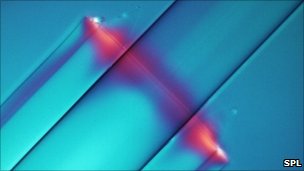Sep 14 2010
Scientists from the University of Southampton’s Optoelectronics Research Centre have developed a new device that could significantly enhance the fiber optic networks’ data capacity. According to the scientists, the YouTube and iPlayer applications will increase the limits of long-range fiber links.
 Light micrograph in a fiber optic cable
Light micrograph in a fiber optic cable
The device uses an auto-tune software that would help remove the interference induced by amplifiers and other signals. The system can be plugged directly into the current generations of networks.
Data is transferred as a series of bits and sent through an optical fiber. However, the bits can become distorted over the enormous lengths of the optical fiber. This can occur as a result of cross talk and phase noise signals. Although these interferences can be removed with existing electronics, the data capacity is reduced. The new device can remove such noisy signal and resend it with full capacity. The device utilizes latest advancements in laser and optical fiber technologies, which lock the signal and differentiate it from noise.
Project researcher, Periklis Petropoulos stated that the demonstration indicates that it is possible to tap the optical fiber’s capabilities without being curbed by the interferences caused by electronic devices.